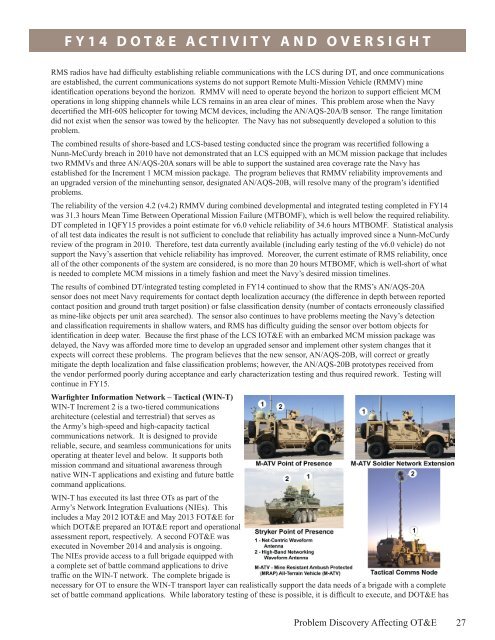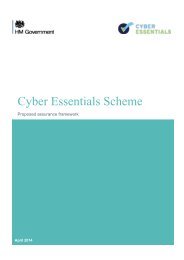- Page 1: Director, Operational Test and Eval
- Page 6 and 7: FY14 Introductionvariance, which su
- Page 8 and 9: FY14 Introductionhave the ability t
- Page 10 and 11: FY14 Introductiondesign for reliabi
- Page 12 and 13: FY14 IntroductionAlso in 2014, my o
- Page 14 and 15: xiiFY14 Introduction
- Page 16 and 17: FY14 Table of ContentsCVN-78 Gerald
- Page 18 and 19: xviFY14 Table of Contents
- Page 20 and 21: DOT&E Activityand Oversight
- Page 22 and 23: FY14 DOT&E Activity and oversightEn
- Page 24 and 25: FY14 DOT&E Activity and oversightLi
- Page 26 and 27: FY14 DOT&E Activity and oversightOt
- Page 30 and 31: FY14 DOT&E Activity and oversightNA
- Page 32 and 33: 12FY14 DOT&E Activity and oversight
- Page 34 and 35: FY14 DOT&E Activity and oversightOt
- Page 36 and 37: FY14 DOT&E Activity and oversightSu
- Page 38 and 39: FY14 DOT&E Activity and oversightNe
- Page 40: FY14 DOT&E Activity and oversightin
- Page 43 and 44: FY14 DOT&E Activity and oversighten
- Page 48 and 49: FY14 DOT&E Activity and oversightno
- Page 50 and 51: FY14 DOT&E Activity and oversightPr
- Page 52 and 53: 32FY14 DOT&E Activity and oversight
- Page 54 and 55: DOD Programs
- Page 56 and 57: FY14 DOD PROGRAMStest VLER v2.0.2.0
- Page 58 and 59: FY14 DOD PROGRAMSdisplayed clinical
- Page 60 and 61: FY14 DOD PROGRAMSActivity• Telepo
- Page 62 and 63: FY14 DOD PROGRAMS--Further adjustme
- Page 64 and 65: FY14 DOD PROGRAMS--Demonstrated the
- Page 66 and 67: FY14 DOD PROGRAMSfor use in the OUE
- Page 68 and 69: FY14 DOD PROGRAMS• The program ad
- Page 70: FY14 DOD PROGRAMSaddition, the prog
- Page 73 and 74: FY14 DOD PROGRAMSof all capability
- Page 75 and 76: FY14 DOD PROGRAMSflight test. The c
- Page 77 and 78: FY14 DOD PROGRAMScold working proce
- Page 79 and 80: FY14 DOD PROGRAMSthe shot into the
- Page 81 and 82: FY14 DOD PROGRAMSoperational fleet,
- Page 83 and 84: FY14 DOD PROGRAMSall metrics and al
- Page 85 and 86: FY14 DOD PROGRAMScompared to an est
- Page 87 and 88: FY14 DOD PROGRAMS--In future versio
- Page 89 and 90: FY14 DOD PROGRAMSdiagnostic Measure
- Page 91 and 92: FY14 DOD PROGRAMSships. ACE represe
- Page 93 and 94: FY14 DOD PROGRAMSand Marine Corps I
- Page 95 and 96:
FY14 DOD PROGRAMSGlobal Command and
- Page 97 and 98:
FY14 DOD PROGRAMSenvironments where
- Page 99 and 100:
FY14 DOD PROGRAMSJoint Information
- Page 101 and 102:
FY14 DOD PROGRAMSJoint Warning and
- Page 103 and 104:
FY14 DOD PROGRAMSKey Management Inf
- Page 105 and 106:
FY14 DOD PROGRAMS• JITC did not e
- Page 107 and 108:
FY14 DOD PROGRAMSPublic Key Infrast
- Page 109 and 110:
FY14 DOD PROGRAMSare expiring, ther
- Page 111 and 112:
Army Programs
- Page 113 and 114:
FY14 ARMY PROGRAMSNetwork Integrati
- Page 115 and 116:
FY14 Army PROGRAMSDependence on FSR
- Page 117 and 118:
FY14 ARMY PROGRAMSAH-64EExecutive S
- Page 119 and 120:
FY14 Army PROGRAMSeffectiveness is
- Page 121 and 122:
FY14 ARMY PROGRAMSAN/PRC-117GExecut
- Page 123 and 124:
FY14 ARMY PROGRAMSC-17 Increased Gr
- Page 125 and 126:
FY14 ARMY PROGRAMSDistributed Commo
- Page 127 and 128:
FY14 ARMY PROGRAMSDOD Automated Bio
- Page 129 and 130:
FY14 Army PROGRAMSresponses, or sys
- Page 131 and 132:
FY14 ARMY PROGRAMSExcalibur Increme
- Page 133 and 134:
FY14 ARMY PROGRAMSGuided Multiple L
- Page 135 and 136:
FY14 ARMY PROGRAMSIntegrated Person
- Page 137 and 138:
FY14 ARMY PROGRAMSJoint Battle Comm
- Page 139 and 140:
FY14 ARMY PROGRAMSJoint Light Tacti
- Page 141 and 142:
FY14 ARMY PROGRAMSJoint Tactical Ne
- Page 143 and 144:
FY14 ARMY PROGRAMSM80A1 7.62 mm Car
- Page 145 and 146:
FY14 ARMY PROGRAMSM109 Family of Ve
- Page 147 and 148:
FY14 ARMY PROGRAMSM829E4 Armor Pier
- Page 149 and 150:
FY14 Army PROGRAMSRecommendations
- Page 151 and 152:
FY14 ARMY PROGRAMSManpack RadioExec
- Page 153 and 154:
FY14 ARMY PROGRAMSMine Resistant Am
- Page 155 and 156:
FY14 ARMY PROGRAMSNett WarriorExecu
- Page 157 and 158:
FY14 ARMY PROGRAMSPatriot Advanced
- Page 159 and 160:
FY14 ARMY PROGRAMSPrecision Guidanc
- Page 161 and 162:
FY14 ARMY PROGRAMSQ-53 Counterfire
- Page 163 and 164:
FY14 ARMY PROGRAMSRifleman RadioExe
- Page 165 and 166:
FY14 ARMY PROGRAMSRQ-7BV2 Shadow Ta
- Page 167 and 168:
FY14 Army PROGRAMS• During FOT&E,
- Page 169 and 170:
FY14 ARMY PROGRAMSWarfighter Inform
- Page 171 and 172:
FY14 Army PROGRAMS- Prior to the Ma
- Page 173 and 174:
Navy Programs
- Page 175 and 176:
FY14 Navy PROGRAMSAegis Modernizati
- Page 177 and 178:
FY14 Navy PROGRAMSAegis- equipped S
- Page 179 and 180:
FY14 Navy PROGRAMSAGM-88E Advanced
- Page 181 and 182:
FY14 Navy PROGRAMSAIM-9X Air-to-Air
- Page 183 and 184:
FY14 Navy PROGRAMSAN/SQQ-89A(V)15 I
- Page 185 and 186:
FY14 Navy PROGRAMSArmored Tactical
- Page 187 and 188:
FY14 Navy PROGRAMSCobra King(former
- Page 189 and 190:
FY14 Navy PROGRAMSCommon Aviation C
- Page 191 and 192:
FY14 Navy PROGRAMSCVN-78 Gerald R.
- Page 193 and 194:
FY14 Navy PROGRAMSAAG• The Navy c
- Page 195:
FY14 Navy PROGRAMSone aircraft. Fol
- Page 198 and 199:
FY14 Navy PROGRAMSMission• The Na
- Page 200 and 201:
FY14 Navy PROGRAMS• FY14 Recommen
- Page 202 and 203:
FY14 Navy PROGRAMSAssessment• Dur
- Page 204 and 205:
FY14 Navy PROGRAMSDefense Acquisiti
- Page 206 and 207:
FY14 Navy PROGRAMSMission• Combat
- Page 208 and 209:
FY14 Navy PROGRAMSActivity• COTF
- Page 210 and 211:
FY14 Navy PROGRAMSsystem to be test
- Page 212 and 213:
FY14 Navy PROGRAMSActivityIDECM Blo
- Page 214 and 215:
FY14 Navy PROGRAMSActivity• The N
- Page 216 and 217:
190FY14 Navy PROGRAMS
- Page 218 and 219:
FY14 Navy PROGRAMS123,000 software
- Page 220 and 221:
FY14 Navy PROGRAMSActivity• The N
- Page 222 and 223:
FY14 Navy PROGRAMSSystemSeaframes
- Page 224 and 225:
FY14 Navy PROGRAMS--USS Independenc
- Page 226 and 227:
FY14 Navy PROGRAMSshore‐based Nav
- Page 228 and 229:
FY14 Navy PROGRAMS• During a shor
- Page 230 and 231:
FY14 Navy PROGRAMSand is continuing
- Page 232 and 233:
FY14 Navy PROGRAMSequipment capable
- Page 234 and 235:
208FY14 Navy PROGRAMS
- Page 236 and 237:
FY14 Navy PROGRAMSAssessment• The
- Page 238 and 239:
FY14 Navy PROGRAMS• Block 3 - Com
- Page 240 and 241:
214FY14 Navy PROGRAMS
- Page 242 and 243:
FY14 Navy PROGRAMSvehicles and a 20
- Page 244 and 245:
FY14 Navy PROGRAMSActivity• Opera
- Page 246 and 247:
220FY14 Navy PROGRAMS
- Page 248 and 249:
FY14 Navy PROGRAMS• The Navy inte
- Page 250 and 251:
224FY14 Navy PROGRAMS
- Page 252 and 253:
FY14 Navy PROGRAMS• Since May 201
- Page 254 and 255:
FY14 Navy PROGRAMSdegraded performa
- Page 256 and 257:
FY14 Navy PROGRAMS- Operational pil
- Page 258 and 259:
FY14 Navy PROGRAMStarget tactics. F
- Page 260 and 261:
FY14 Navy PROGRAMSunable to execute
- Page 262 and 263:
FY14 Navy PROGRAMS▪▪The Navy ha
- Page 264 and 265:
FY14 Navy PROGRAMS- The system’s
- Page 266 and 267:
FY14 Navy PROGRAMSproblems with fal
- Page 268 and 269:
FY14 Navy PROGRAMSActivity• The N
- Page 270 and 271:
244FY14 Navy PROGRAMS
- Page 272 and 273:
FY14 Navy PROGRAMSoperational test
- Page 274 and 275:
FY14 Navy PROGRAMSperform the calib
- Page 276 and 277:
FY14 Navy PROGRAMS• The Navy deve
- Page 278 and 279:
252FY14 Navy PROGRAMS
- Page 280 and 281:
FY14 Navy PROGRAMSActivity• On Fe
- Page 282 and 283:
Air Force Programs
- Page 284 and 285:
FY14 Air Force PROGRAMSActivity•
- Page 286 and 287:
258FY14 Air Force PROGRAMS
- Page 288 and 289:
FY14 Air Force PROGRAMSTechsystems
- Page 290 and 291:
FY14 Air Force PROGRAMS• The ISR
- Page 292 and 293:
FY14 Air Force PROGRAMS• AOC-WS 1
- Page 294 and 295:
266FY14 Air Force PROGRAMS
- Page 296 and 297:
FY14 Air Force PROGRAMSActivity•
- Page 298 and 299:
FY14 Air Force PROGRAMSAssessment
- Page 300 and 301:
FY14 Air Force PROGRAMSActivity•
- Page 302 and 303:
FY14 Air Force PROGRAMSActivity•
- Page 304 and 305:
FY14 Air Force PROGRAMSservices to
- Page 306 and 307:
FY14 Air Force PROGRAMSof unintenti
- Page 308 and 309:
FY14 Air Force PROGRAMS▪▪Observ
- Page 310 and 311:
FY14 Air Force PROGRAMSKC‐46A has
- Page 312 and 313:
284FY14 Air Force PROGRAMS
- Page 314 and 315:
FY14 Air Force PROGRAMSAssessment
- Page 316 and 317:
FY14 Air Force PROGRAMSActivity•
- Page 318 and 319:
290FY14 Air Force PROGRAMS
- Page 320 and 321:
FY14 Air Force PROGRAMS• The fina
- Page 322 and 323:
FY14 Air Force PROGRAMSActivity•
- Page 324 and 325:
296FY14 Air Force PROGRAMS
- Page 326 and 327:
FY14 Air Force PROGRAMS• As SDB I
- Page 328 and 329:
Ballistic MissileDefense Systems
- Page 330 and 331:
FY14 BALLISTIC MISSILE DEFENSE SYST
- Page 332 and 333:
302FY14 BALLISTIC MISSILE DEFENSE S
- Page 334 and 335:
FY14 BALLISTIC MISSILE DEFENSE SYST
- Page 336 and 337:
FY14 BALLISTIC MISSILE DEFENSE SYST
- Page 338 and 339:
FY14 BALLISTIC MISSILE DEFENSE SYST
- Page 340 and 341:
310FY14 BALLISTIC MISSILE DEFENSE S
- Page 342 and 343:
FY14 BALLISTIC MISSILE DEFENSE SYST
- Page 344 and 345:
FY14 BALLISTIC MISSILE DEFENSE SYST
- Page 346 and 347:
316FY14 BALLISTIC MISSILE DEFENSE S
- Page 348 and 349:
FY14 BALLISTIC MISSILE DEFENSE SYST
- Page 350 and 351:
Live Fire Testand Evaluation
- Page 352 and 353:
FY14 LFT&E PROGRAMThe fielded JWS v
- Page 354 and 355:
FY14 LFT&E PROGRAMa desired ejectio
- Page 356 and 357:
FY14 LFT&E PROGRAMconsultation to w
- Page 358 and 359:
FY14 LFT&E PROGRAMTesting and Evalu
- Page 360 and 361:
FY14 LFT&E PROGRAMWARRIOR INJURY AS
- Page 362 and 363:
330FY14 LFT&E PROGRAM
- Page 364 and 365:
Cybersecurity
- Page 366 and 367:
FY14 CYBERSECURITYsupport to DOT&E
- Page 368 and 369:
FY14 CYBERSECURITYExerciseAuthority
- Page 370 and 371:
FY14 CYBERSECURITYsome responses we
- Page 372 and 373:
338FY14 CYBERSECURITY
- Page 374 and 375:
Test and EvaluationResources
- Page 376 and 377:
FY14 test and evaluation resources(
- Page 378 and 379:
FY14 test and evaluation resourcesR
- Page 380 and 381:
FY14 test and evaluation resourceso
- Page 383 and 384:
FY14 test and evaluation resourcest
- Page 385 and 386:
FY14 test and evaluation resourcesS
- Page 387 and 388:
Joint Test andEvaluation
- Page 389 and 390:
FY14 JT&E ProgramJoint Test and Eva
- Page 391 and 392:
FY14 JT&E ProgramQuick Reaction Tes
- Page 393 and 394:
FY14 JT&E Program- Assess and graph
- Page 395 and 396:
Center forCountermeasures
- Page 397 and 398:
FY14 Center for countermeasuresCent
- Page 399 and 400:
FY14 Center for countermeasures•
- Page 401 and 402:
FY14 Center for countermeasuresThe
- Page 403 and 404:
Index
- Page 405 and 406:
Index of ProgramsAAC-130J Ghostride
- Page 407 and 408:
FY14 Index of ProgramsLLHA-6 New Am
- Page 410:
DOT&E Activity and OversightDOD Pro







